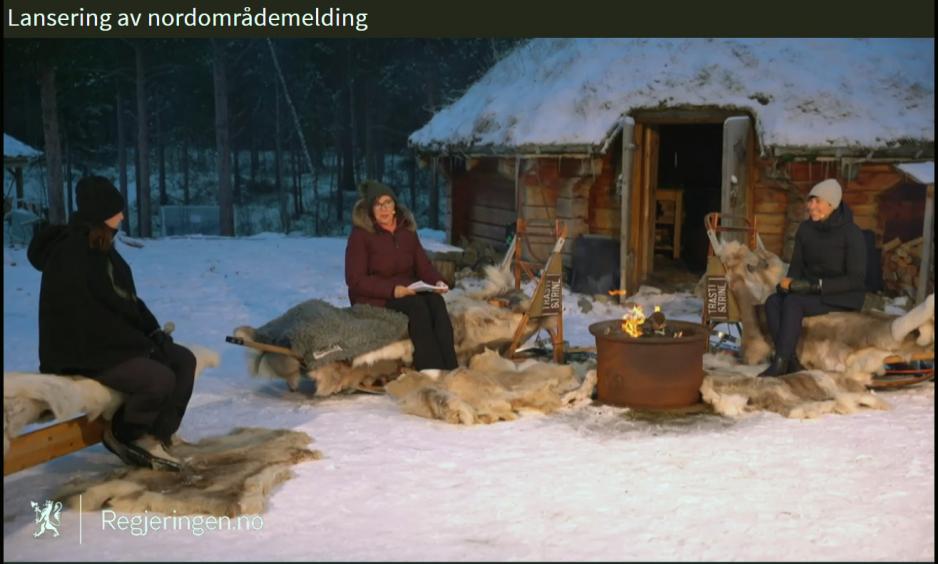The High North Whitepaper – Or That Time When A Seal Kissed the Minister

The High North Youth Whitepaper argues that we need to “remove the image of Northern Norway as a windblow place with ramshackle buildings in a dark polar desert”. This is what it looked like when the Norwegian government presented the High North whitepaper. Foreign minister Ine Eriksen Søreide to the right. (Photo: Screenshot from the government’s press conference.)
Commentary: One of the Norwegian government’s strongest cards during the presentation of the High North whitepaper was frequent meetings with North Norwegian actors. Or in the words of Trade Minister Iselin Nybø in a video interview with the Nordlys daily: “One of the funniest meetings was at Polaria in Tromsø, when I was kissed by a seal.”
Well, in total, the government has brought back more than that from the region during the work process, and in particular it has noted the claim about lack of investment capital. Massive profits, not to mention in the fish farming industry, has not triggered investments in other industries. Towards the end, according to what High North News has been told, the government therefore included a regional and national Dutch treat in its whitepaper.
The Ministry of Finance won
Without this financial Dutch treat, the High North whitepaper would have had the appearance of a complete victory for the Ministry of Finance, one in which phrases like “shall, strengthen and expand” are replaced almost all over with more non-committal phrases like “stimulate, facilitate, investigate and continue”.
Northern business actors have wanted a fully state-owned investment fund localized in the High North, following the model from other state-owned funds. Now, the Norwegian state will come up with the half billion kroner probably needed, whereas business and enterprises are to contribute with the other half.
The government shall stimulate, facilitate, investigate
The last time they tried doing that, the fund capsized in a mashup of localization debates and disagreements over investment profile. Whether or not Northern Norway manages to agree this time around, remains to be seen. Prime Minister Erna Solberg said at the presentation of the High North whitepaper that she will not accept any failure due to localization debate for this initiative.
The PM’s prayers should definitely be heard
However, a whitepaper is not a budget proposal, nor is this whitepaper from the government. This is primarily a whitepaper to parliament, Stortinget, that describes the potential of the High North adequately without it being followed up by phrases involving commitment.
In the budget work, the High North has gone from triggering billion investments to becoming the object of more general, national tools. That is made sure in particular by the Ministry of Finance.
However, the whitepaper is also characterized by a lack of support within the government of the very rationale behind writing a separate whitepaper about the High North; the international situation and the economic potential located in the North.
The PM’s prayers should definitely be heard
The Ministry of Foreign Affairs is still the formal writer of the whitepaper, however, its contents is – when compared to former High North whitepapers – primarily a Northern Norway whitepaper.
From the High North to Northern Norway
Many have probably wanted that, in particular after the Agrarian Party started surging in the polls.
The weakness of this is that the international aspect, along with security policies, is pushed to the back. The security policy situation is dramatically changed since the previous whitepaper about the High North. As is market access for the export-oriented part of North Norwegian business and industry.
Adding to this the fact that the biggest challenge, population decrease, cannot be solved without access to foreign capital, competence and work power, I do not share the excitement over the shift towards the national aspect.
While the High North whitepaper was presented, Statistics Norway provided rather precise descriptions of the development in the North. Population continues to decrease in both counties, and as an outcome of that, a series of primary schools are shut down. There is no use in funding school operations in neither towns nor rural districts if the number of pupils is not enough to defend it.
A dark, windblown polar desert
However, there is not much use in extracting economic resources in the High North either, if the demographic development continues.
In its preparatory work on the High North whitepaper, the government has stressed input from young people. It has even made its on High North Youth Whitepaper, which is most worthy of a read. One piece of advice from the young is to “remove the image of Northern Norway as a windblow place with ramshackle buildings in a dark polar desert”.
Remarkable then, perhaps even illustrating, is it that the government chose to present a whitepaper providing a good description of the potential in the High North in exactly such surroundings.
In a dark icy desert, in front of a log fire.
This commentary was originally published in Norwegian and has been translated by HNN's Elisabeth Bergquist.

